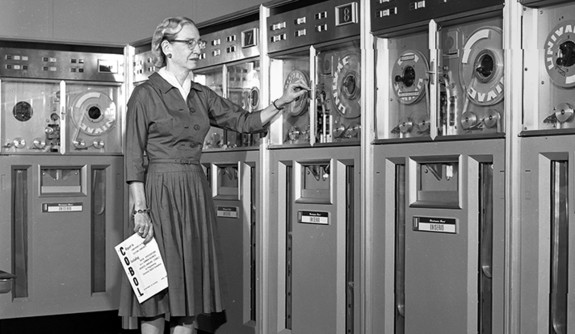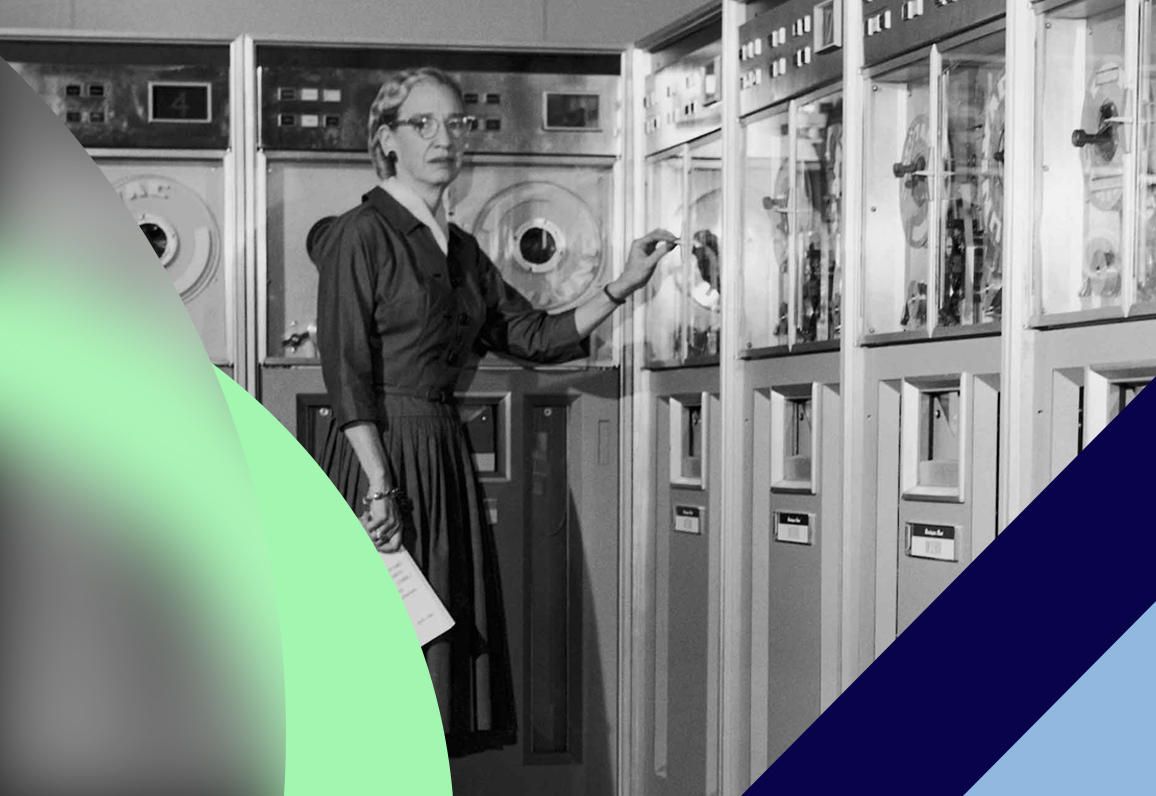1. Jean E. Sammet – The Creator of the First Widely Used Programming Language
Jean E. Sammet graduated with an MA in Mathematics in 1949. In 1961, she became manager of IBM’s Programming Center in Boston and oversaw the development of FORMAC (FORmula MAnipulation Compiler), the first widely used general language and the first to manipulate symbolic algebraic expressions.
2. Grace Hopper – The US Navy Admiral Turned Computing Pioneer
Grace Murray Hopper was responsible for developing the 1st compiler for a computer programming language. She was a US Navy Rear Admiral, and in 1973 she became the first person from the USA and the first woman to ever to be made a Distinguished Fellow of the British Computer Society. She’s also an IEEE Fellow, and the winner of the Society of Women Engineers Achievement Award 1964.
3. Ada ‘Lovelace’ – The World’s First Computer Programmer
Augusta Ada King Countess of Lovelace, daughter of the British Romantic poet Lord Byron, is recognised as the world’s first computer programmer. In 1842 she wrote the first ever algorithm for processing numbers on Charles Bannage’s early mechanical general-purpose computer or analytical engine who, so impressed by her mathematical skills, referred to her as ‘The Enchantress of Numbers”. The computer language ADA was named after her.
4. Katherine Johnson – The Orbital Mathematician Behind Apollo 11
Katherine Johnson, also known as Katherine Goble, was an American mathematician whose calculations of orbital mechanics as a NASA employee were critical to the success of the first and subsequent U.S. crewed spaceflights. During her 35-year career at NASA and its predecessor, she earned a reputation for mastering complex manual calculations and helped pioneer the use of computers to perform the tasks. The space agency noted her “historical role as one of the first African-American women to work as a NASA scientist”.
5. Radia Perlamn – “The Mother of the Internet”
Radia Perlman is a Fellow at Dell EMC and is the inventor behind much of the technology at the heart of the Internet, including robust, scalable and autoconfiguring routing technology. Perlman invented the spanning tree algorithm, which is what “Ethernet” is today. She also has made various contributions in network security, including scalable data expiration, distributed algorithms despite malicious participants, DDOS prevention techniques and user authentication. Radia has been recognized with many industry honors including induction into the National Academy of Engineering, the Inventor Hall of Fame, the Internet Hall of Fame, and lifetime achievement awards from Usenix and SIGCOMM. She currently holds over 100 patents, and has a PhD in computer science from MIT.
6. Sister Mary Kenneth Keller – The US’ First Woman to be Awarded a PHD in Computer Science
In 1965, Mary Kenneth Keller was the first woman in the US to be awarded a PhD in Computer Science, having previously studied Mathematics and Physics. Earlier she had taken her vows as a Roman Catholic religious sister in Ohio and in 1958 had started work at Dartford College in the male-only (at the time) computer centre. At Dartford Mary worked on developing the BASIC programming language. BASIC is a way of translating the zeroes and ones of computer code into something more intuitive and straightforward. It is a general-purpose, high level programming language which helped broaden computer programming into non maths and science fields, subsequently giving many people their first experience with programming.
7. Dr. Ellen Ochoa – First Female Hispanic Astronaut & Hall of Famer
Dr. Ellen Ochoa is an American engineer, former astronaut and director of the Johnson Space Center. She was selected by NASA in 1990 and in 1991 became the world’s first Hispanic female astronaut. A mission specialist and flight engineer, Ochoa is a veteran of four space flights, logging more than 950 hours in space. Ochoa has received many awards among which are NASA’s Distinguished Service Medal, Exceptional Service Medal, Outstanding Leadership Medal (1995) and Space Flight Medals. She was also inducted into the United States Astronaut Hall of Fame in 2017, and the International Air and Space Hall of Fame in 2018.

Grace Hopper works on COBOL Computer Programming Language
8. Margaret Hamilton – The First “Software Engineer” and Presidential Medal of Freedom Winner
Margaret Hamilton, is an American computer scientist who was one of the first computer software programmers; she created the term software engineer to describe her work. Hamilton led the software engineering division at Massachusetts Institute of Technology’s Instrumentation Laboratory in the late 60’s and early 70’s and helped write the computer code for the command and lunar modules used on the six Apollo landing missions to the Moon between 1969 and 1972. in 2016 Margaret Hamilton received the Presidential Medal of Freedom for her contributions to software development, which Obama said “set the foundation for modern, ultra-reliable software design and engineering”.
9. Beatrice Worsley – Canada’s First Female Computer Scientist
Beatrice Worsley, was a pioneering Canadian computer scientist, professor, and researcher in the emerging field of computer science in the 1940s. Worsley is considered to be the first female computer scientist in Canada and was honoured with a lifetime achievement award from the Canadian Association of Computer Science in 2014.
10. “The Women of ENIAC”
In 1946 six brilliant young women, Jean Jennings, Marlyn Meltzer, Ruth Lichterman, Betty Snyder, Frances Bilas, and Kay McNulty programmed the first all-electronic, programmable computer, called the ENIAC.ENIAC was a project run by the U.S. Army in Philadelphia as part of a secret World War II programme. Dubbed ‘the ENIAC Women’, Jennings, Meltzer, Lichterman, Snyder, Bilas, and McNulty programmed the computer without the use of programming languages or tools (for none existed) — only logical diagrams. By the time they were finished, ENIAC ran a ballistics trajectory — a differential calculus equation – in seconds. When ENIAC was unveiled to the public after the war, the women received little to no recognition for their historic contribution to computing.






